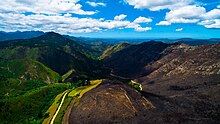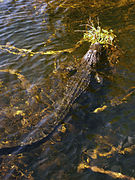| |
|
|
Ecology
|
|
Ecology (from Ancient Greek οἶκος (oîkos) 'house', and -λογία (-logía) 'study of') is the natural science of the relationships among living organisms, including humans, and their physical environment. Ecology considers organisms at the individual, population, community, ecosystem, and biosphere levels. Ecology overlaps with the closely related sciences of biogeography, evolutionary biology, genetics, ethology, and natural history. Ecology is a branch of biology, and is the study of abundance, biomass, and distribution of organisms in the context of the environment. It encompasses life processes, interactions, and adaptations; movement of materials and energy through living communities; successional development of ecosystems; cooperation, competition, and predation within and between species; and patterns of biodiversity and its effect on ecosystem processes. Ecology has practical applications in conservation biology, wetland management, natural resource management (agroecology, agriculture, forestry, agroforestry, fisheries, mining, tourism), urban planning (urban ecology), community health, economics, basic and applied science, and human social interaction (human ecology). The word ecology (German: Ökologie) was coined in 1866 by the German scientist Ernst Haeckel. The science of ecology as we know it today began with a group of American botanists in the 1890s. Evolutionary concepts relating to adaptation and natural selection are cornerstones of modern ecological theory. Ecosystems are dynamically interacting systems of organisms, the communities they make up, and the non-living (abiotic) components of their environment. Ecosystem processes, such as primary production, nutrient cycling, and niche construction, regulate the flux of energy and matter through an environment. Ecosystems have biophysical feedback mechanisms that moderate processes acting on living (biotic) and abiotic components of the planet. Ecosystems sustain life-supporting functions and provide ecosystem services like biomass production (food, fuel, fiber, and medicine), the regulation of climate, global biogeochemical cycles, water filtration, soil formation, erosion control, flood protection, and many other natural features of scientific, historical, economic, or intrinsic value. (Full article...) Selected article - In ecology, a disturbance is a temporary change in environmental conditions that causes a pronounced change in an ecosystem. Disturbances often act quickly and with great effect, to alter the physical structure or arrangement of biotic and abiotic elements. A disturbance can also occur over a long period of time and can impact the biodiversity within an ecosystem. Major ecological disturbances may include fires, flooding, storms, insect outbreaks and trampling. Earthquakes, various types of volcanic eruptions, tsunami, firestorms, impact events, climate change, and the devastating effects of human impact on the environment (anthropogenic disturbances) such as clearcutting, forest clearing and the introduction of invasive species can be considered major disturbances. (Full article...)Selected image -Credit: Nicolas Pourcelot A limule (Horseshoe crab) in the Hạ Long Bay, Quảng Ninh province, Vietnam. Horseshoe crabs are arthropods that live primarily in shallow ocean waters on soft sandy or muddy bottoms.
General imagesThe following are images from various ecology-related articles on Wikipedia.
Related WikiProjectsThings you can do
Entries here consist of Good and Featured articles, which meet a core set of high editorial standards.
 Underwater camouflage is the set of methods of achieving crypsis—avoidance of observation—that allows otherwise visible aquatic organisms to remain unnoticed by other organisms such as predators or prey. Camouflage in large bodies of water differs markedly from camouflage on land. The environment is essentially the same on all sides. Light always falls from above, and there is generally no variable background to compare with trees and bushes. Near to the sea surface reflectivity and blue coloration are the most common form of camouflage. Below, countershading is more common, with blue coloration on the dorsal side and white on the ventral side. Below the epipelagic zone transparency is more frequent. In the aphotic zone red and black coloration are common, often in combination with bioluminescence. At the very deepest areas such as the benthic regions of the hadal zone, most animals use pale red and cream colors. (Full article...)Selected biography - Elsie Quarterman (November 28, 1910 – June 9, 2014) was a prominent plant ecologist. She was a professor emerita at Vanderbilt University. Quarterman was born on November 28, 1910, in Valdosta, Georgia. She earned a B.A. from Georgia State Women's College (now Valdosta State University) in 1932 and earned an M.A. in botany from Duke University in 1943. She completed her PhD at Duke University in 1949 with Henry J. Oosting. During her graduate work and afterward, she also collaborated extensively with Catherine Keever. (Full article...)Did you know (auto-generated)
Selected quote -
Ecology news
Additional News Highlights
Selected publication -The Open Hematology Journal is an open-access peer-reviewed medical journal covering ecology. It publishes reviews and letters in all areas of clinical, laboratory, and experimental hematology including stem cells and blood disorders. (Full article...) Related portalsMore did you know -Related articlesAssociated WikimediaThe following Wikimedia Foundation sister projects provide more on this subject:
Web resources
Discover Wikipedia using portals |














































